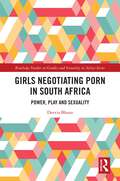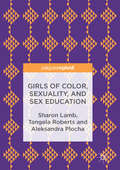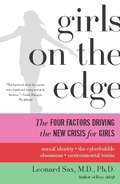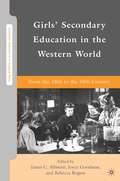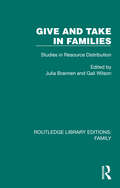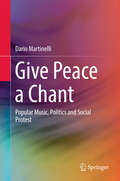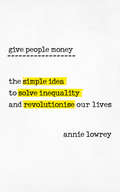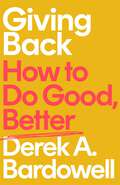- Table View
- List View
Girls Negotiating Porn in South Africa: Power, Play and Sexuality (Routledge Studies on Gender and Sexuality in Africa)
by Deevia BhanaThe book investigates how teenage girls in South Africa encounter and consume pornography, situating their experiences within wider sociocultural and affective relations of power. It focuses on girls’ online playful and pleasurable pursuits as they explore and expand upon their sexual curiosities. In this digital moment, the book directs us to the multi-layered meanings around porn, as an everyday normative experience. The book takes on an interdisciplinary approach drawing from and inspired by new feminist materialism and assemblage theorising. For teenage girls porn is freely available to see in billboards, magazines, books, on television, music videos, games, online streaming and social media sites. Girls do not have to view hardcore porn to see porn: it is everywhere. It argues that girls’ online playful adventures are a critical site for learning, developing, and negotiating gender and sexuality. These meanings are constitutive of pleasure and the pursuit of learning sexually, but they also provide a launchpad for girls to contest race, gender, and heterosexual domination while opening up online porn to broader interrogation and critique. The book will be of interest to researchers across African studies, sociology, psychology, anthropology, youth, gender and sexuality studies, porn studies, and childhood studies.
Girls of Color, Sexuality, and Sex Education
by Sharon Lamb Tangela Roberts Aleksandra PlochaThis book takes a close look at how girls of color think, talk, and learn about sex and sexual ethics, how they navigate their developing sexuality through cultural stereotypes about sex and body image, and how they negotiate their sexual learning within a co-ed sex education classroom. While girls of color are often pictured as at risk or engaged in risky behavior, the analyses of focus groups and classroom discussions, show not only girls’ vulnerabilities but their strengths as they work with integrating diverse identities, media messages, school policy and history into their understanding of the sexual world they are exposed to and a part of.
Girls of Color, Sexuality, and Sex Education
by Sharon Lamb Tangela Roberts Aleksandra PlochaThis book takes a close look at how girls of color think, talk, and learn about sex and sexual ethics, how they navigate their developing sexuality through cultural stereotypes about sex and body image, and how they negotiate their sexual learning within a co-ed sex education classroom. While girls of color are often pictured as at risk or engaged in risky behavior, the analyses of focus groups and classroom discussions, show not only girls’ vulnerabilities but their strengths as they work with integrating diverse identities, media messages, school policy and history into their understanding of the sexual world they are exposed to and a part of.
Girls on the Edge: The Four Factors Driving the New Crisis for Girls-Sexual Identity, the Cyberbubble, Obsessions, Envi
by Leonard SaxA parenting expert reveals the four biggest threats to girls' psychological growth and explains how parents can help their daughters develop a healthy sense of self.In Girls on the Edge, psychologist and physician Leonard Sax argues that many girls today have a brittle sense of self-they may look confident and strong on the outside, but they're fragile within. Sax offers the tools we need to help them become independent and confident women, and provides parents with practical tips on everything from helping their daughter limit her time on social media, to choosing a sport, to nurturing her spirit through female-centered activities. Compelling and inspiring, Girls on the Edge points the way to a new future for today's girls and young women.
Girls' Secondary Education in the Western World: From the 18th to the 20th Century (Secondary Education in a Changing World)
by J. Goodman R. Rogers J. AlbisettiThe collection's focus is on girls' secondary education, and hence the gendered cultural expectations of the middle classes and upper classes, will provide the dominant narrative, given the relatively recent democratization of European educational systems.
Girls, Single-Sex Schools, and Postfeminist Fantasies (Routledge Critical Studies in Gender and Sexuality in Education)
by Stephanie D. McCallBringing together feminist theory, girlhood studies, and curriculum theory, this book contributes an in-depth critical analysis of curriculum in single-gender schooling for girls in postfeminist landscapes of "unlimited choices" and resurgences of proper girlhood. The arguments challenge the mainstream assumptions and promotions about the guarantees of female success via small school supports, tailored curricula, protection, school choice and class advantage. Single-gender schools are not homogenous; they have different histories, student populations, finances and organization. Recognizing this diversity, Girls, Single-sex Schools, and Postfeminist Fantasies draws on rich data collected in two US secondary schools over a two-year period to identify and explore the ambiguities of success in single-sex schools for girls. Rich classroom observations and interviews with teachers and students reveal the resounding message delivered to girls - that they can "have it all" by going to college. By exploring students’ imaginings, hopes, and doubts around college, the text illustrates how this catalyzes girls’ critiques of their futures and of the schooled storylines of female success. While teachers might trumpet college, career, and limitless horizons, girls seek to understand their social positions and try to make sense of family, passions, and future happiness. This book will be of great interest to graduate and postgraduate students, academics, researchers, libraries in secondary education, girlhood studies, sociology of education, gender and sexuality in education, single-sex schooling, and feminist theory.
Girls, Single-Sex Schools, and Postfeminist Fantasies (Routledge Critical Studies in Gender and Sexuality in Education)
by Stephanie D. McCallBringing together feminist theory, girlhood studies, and curriculum theory, this book contributes an in-depth critical analysis of curriculum in single-gender schooling for girls in postfeminist landscapes of "unlimited choices" and resurgences of proper girlhood. The arguments challenge the mainstream assumptions and promotions about the guarantees of female success via small school supports, tailored curricula, protection, school choice and class advantage. Single-gender schools are not homogenous; they have different histories, student populations, finances and organization. Recognizing this diversity, Girls, Single-sex Schools, and Postfeminist Fantasies draws on rich data collected in two US secondary schools over a two-year period to identify and explore the ambiguities of success in single-sex schools for girls. Rich classroom observations and interviews with teachers and students reveal the resounding message delivered to girls - that they can "have it all" by going to college. By exploring students’ imaginings, hopes, and doubts around college, the text illustrates how this catalyzes girls’ critiques of their futures and of the schooled storylines of female success. While teachers might trumpet college, career, and limitless horizons, girls seek to understand their social positions and try to make sense of family, passions, and future happiness. This book will be of great interest to graduate and postgraduate students, academics, researchers, libraries in secondary education, girlhood studies, sociology of education, gender and sexuality in education, single-sex schooling, and feminist theory.
Girls, Style, and School Identities: Dressing the Part
by S. PomerantzWriting against the grain of popular perception and moral panic, Pomerantz offers an intricate look at the importance of style for girls in school. Based on a year long ethnography in a Canadian high school, Pomerantz highlights style as a meaning-making practice that demands to be taken seriously.
Girls with Guns: Firearms, Feminism, and Militarism
by France Winddance TwineA nuanced understanding of state violence and gender (in)equalities must consider the varied and contradictory experiences of armed civilian women, female soldiers, and opponents of gun possession. How is ‘feminism’ and ‘femininity’ negotiated in the early 21st century by civilian and military women in a nation that fetishizes guns? This book addresses this social problem by offering a comparative analysis of the particular dilemmas that gender inequality, class inequality, race/racism and U.S. nationalism generate for women of diverse backgrounds who are struggling to balance conventional gender roles, femininity and gendered violence in the United States.
Girls with Guns: Firearms, Feminism, and Militarism
by France Winddance TwineA nuanced understanding of state violence and gender (in)equalities must consider the varied and contradictory experiences of armed civilian women, female soldiers, and opponents of gun possession. How is ‘feminism’ and ‘femininity’ negotiated in the early 21st century by civilian and military women in a nation that fetishizes guns? This book addresses this social problem by offering a comparative analysis of the particular dilemmas that gender inequality, class inequality, race/racism and U.S. nationalism generate for women of diverse backgrounds who are struggling to balance conventional gender roles, femininity and gendered violence in the United States.
Giroux Reader
by Henry A. Giroux Christopher G. RobbinsOne of the world's leading social critics and educational theorists, Henry A. Giroux has contributed significantly to critical pedagogy, cultural studies, youth studies, social theory, and cultural politics. This new book offers a carefully selected cross-section of Giroux's many scholarly and popular writings, which bridge the theoretical and practical, integrate multiple academic disciplines, and fuse scholarly rigor with social relevance. The essays underscore the continuities and transformations in Giroux's thought, just as they offer invaluable approaches to understanding a range of social problems. Giroux's work suggests that a more humane and democratic world is possible and provides critical tools that can assist concerned citizens in bringing it into being.
Giroux Reader
by Henry A. Giroux Christopher G. RobbinsOne of the world's leading social critics and educational theorists, Henry A. Giroux has contributed significantly to critical pedagogy, cultural studies, youth studies, social theory, and cultural politics. This new book offers a carefully selected cross-section of Giroux's many scholarly and popular writings, which bridge the theoretical and practical, integrate multiple academic disciplines, and fuse scholarly rigor with social relevance. The essays underscore the continuities and transformations in Giroux's thought, just as they offer invaluable approaches to understanding a range of social problems. Giroux's work suggests that a more humane and democratic world is possible and provides critical tools that can assist concerned citizens in bringing it into being.
GIS and Spatial Analysis for the Social Sciences: Coding, Mapping, and Modeling (Sociology Re-Wired)
by Emily K. Asencio Robert Nash ParkerThis is the first book to provide sociologists, criminologists, political scientists, and other social scientists with the methodological logic and techniques for doing spatial analysis in their chosen fields of inquiry. The book contains a wealth of examples as to why these techniques are worth doing, over and above conventional statistical techniques using SPSS or other statistical packages. GIS is a methodological and conceptual approach that allows for the linking together of spatial data, or data that is based on a physical space, with non-spatial data, which can be thought of as any data that contains no direct reference to physical locations.
GIS and Spatial Analysis for the Social Sciences: Coding, Mapping, and Modeling (Sociology Re-Wired)
by Emily K. Asencio Robert Nash ParkerThis is the first book to provide sociologists, criminologists, political scientists, and other social scientists with the methodological logic and techniques for doing spatial analysis in their chosen fields of inquiry. The book contains a wealth of examples as to why these techniques are worth doing, over and above conventional statistical techniques using SPSS or other statistical packages. GIS is a methodological and conceptual approach that allows for the linking together of spatial data, or data that is based on a physical space, with non-spatial data, which can be thought of as any data that contains no direct reference to physical locations.
Give a Little Love: The Zayn Adam Story (Routledge/UNISA Press Series)
by Llewellin RG JegelsThis is the true story of a standout artist in the field of pop and sentimental song; a star entertainer who rose to fame in Cape Town, South Africa. The world reflected in this book has several genealogical strands reaching back to other histories – to the nineteenth century theatre, to the rise of racism in South Africa, and the ways people were forced to negotiate the contradictions of being human against impossible odds. We encounter a biographer with a subject which is close to him, and which he has meticulously researched over a course of time. The book offers insights into the musical world of the phonograph, of the global popular culture after the Second World War and how this was absorbed into Cape Town’s popular culture.
Give a Little Love: The Zayn Adam Story (Routledge/UNISA Press Series)
by Llewellin RG JegelsThis is the true story of a standout artist in the field of pop and sentimental song; a star entertainer who rose to fame in Cape Town, South Africa. The world reflected in this book has several genealogical strands reaching back to other histories – to the nineteenth century theatre, to the rise of racism in South Africa, and the ways people were forced to negotiate the contradictions of being human against impossible odds. We encounter a biographer with a subject which is close to him, and which he has meticulously researched over a course of time. The book offers insights into the musical world of the phonograph, of the global popular culture after the Second World War and how this was absorbed into Cape Town’s popular culture.
Give and Take: Developmental Foreign Aid and the Pharmaceutical Industry in East Africa (Princeton Studies in Global and Comparative Sociology)
by Nitsan ChorevGive and Take looks at local drug manufacturing in Kenya, Tanzania, and Uganda, from the early 1980s to the present, to understand the impact of foreign aid on industrial development. While foreign aid has been attacked by critics as wasteful, counterproductive, or exploitative, Nitsan Chorev makes a clear case for the effectiveness of what she terms “developmental foreign aid.”Against the backdrop of Africa’s pursuit of economic self-sufficiency, the battle against AIDS and malaria, and bitter negotiations over affordable drugs, Chorev offers an important corrective to popular views on foreign aid and development. She shows that when foreign aid has provided markets, monitoring, and mentoring, it has supported the emergence and upgrading of local production. In instances where donors were willing to procure local drugs, they created new markets that gave local entrepreneurs an incentive to produce new types of drugs. In turn, when donors enforced exacting standards as a condition to access those markets, they gave these producers an incentive to improve quality standards. And where technical know-how was not readily available and donors provided mentoring, local producers received the guidance necessary for improving production processes.Without losing sight of domestic political-economic conditions, historical legacies, and foreign aid’s own internal contradictions, Give and Take presents groundbreaking insights into the conditions under which foreign aid can be effective.
Give and Take: Developmental Foreign Aid and the Pharmaceutical Industry in East Africa (Princeton Studies in Global and Comparative Sociology)
by Nitsan ChorevGive and Take looks at local drug manufacturing in Kenya, Tanzania, and Uganda, from the early 1980s to the present, to understand the impact of foreign aid on industrial development. While foreign aid has been attacked by critics as wasteful, counterproductive, or exploitative, Nitsan Chorev makes a clear case for the effectiveness of what she terms “developmental foreign aid.”Against the backdrop of Africa’s pursuit of economic self-sufficiency, the battle against AIDS and malaria, and bitter negotiations over affordable drugs, Chorev offers an important corrective to popular views on foreign aid and development. She shows that when foreign aid has provided markets, monitoring, and mentoring, it has supported the emergence and upgrading of local production. In instances where donors were willing to procure local drugs, they created new markets that gave local entrepreneurs an incentive to produce new types of drugs. In turn, when donors enforced exacting standards as a condition to access those markets, they gave these producers an incentive to improve quality standards. And where technical know-how was not readily available and donors provided mentoring, local producers received the guidance necessary for improving production processes.Without losing sight of domestic political-economic conditions, historical legacies, and foreign aid’s own internal contradictions, Give and Take presents groundbreaking insights into the conditions under which foreign aid can be effective.
Give and Take in Families: Studies in Resource Distribution (Routledge Library Editions: Family)
by Julia BrannenOriginally published in 1987, now with a new preface, the focus of this book is the distribution of material resources, notably money, work, care and food, within and between households. Hitherto, social policy research had tended to roll households and families into one and consider them as ‘private’ spheres which only connected with society via the male head of household – the ‘breadwinner’. Examination of resource distribution had stopped short at the door of the household. The contributors to Give and Take in Families open up the ‘Black Box’ of the family and explore the assumption that resources are equitably distributed between household members. A dominant concern is with gender relations. Each study attempts to make women – as resources in caring for other people, as providers of income, as transformers of income into goods and services – visible in the household unit. Findings from nine empirical studies are presented, examining resource distribution in relation to the composition of households, and the life cycles and life experiences of household members. A wide variety of household types is considered, and attention is given to households undergoing changes (such as divorce and unemployment) that are likely to have major implications for household structure and resources. The implications of these innovative and thought-provoking studies for social policy are considerable, with relevance to the fields of inequality and income support, the provision of care for children and the elderly, the labour market and divorce law. This book will still appeal to practising researchers and students in the social sciences, particularly women’s studies.
Give and Take in Families: Studies in Resource Distribution (Routledge Library Editions: Family)
Originally published in 1987, now with a new preface, the focus of this book is the distribution of material resources, notably money, work, care and food, within and between households. Hitherto, social policy research had tended to roll households and families into one and consider them as ‘private’ spheres which only connected with society via the male head of household – the ‘breadwinner’. Examination of resource distribution had stopped short at the door of the household. The contributors to Give and Take in Families open up the ‘Black Box’ of the family and explore the assumption that resources are equitably distributed between household members. A dominant concern is with gender relations. Each study attempts to make women – as resources in caring for other people, as providers of income, as transformers of income into goods and services – visible in the household unit. Findings from nine empirical studies are presented, examining resource distribution in relation to the composition of households, and the life cycles and life experiences of household members. A wide variety of household types is considered, and attention is given to households undergoing changes (such as divorce and unemployment) that are likely to have major implications for household structure and resources. The implications of these innovative and thought-provoking studies for social policy are considerable, with relevance to the fields of inequality and income support, the provision of care for children and the elderly, the labour market and divorce law. This book will still appeal to practising researchers and students in the social sciences, particularly women’s studies.
Give Peace a Chant: Popular Music, Politics and Social Protest
by Dario MartinelliThis monograph offers a unique analysis of social protest in popular music. It presents theoretical descriptions, methodological tools, and an approach that encompasses various fields of musicology, cultural studies, semiotics, discourse analysis, media studies, and political and social sciences. The author argues that protest songs should be taken as a musical genre on their own. He points out that the general approach, when discussing these songs, has been so far that of either analyzing the lyrics or the social context. For some reason, the music itself has been often overlooked. This book attempts to fill this gap. Its central thesis is that a complete overview of these repertoires demands a thorough interaction among contextual, lyrical, and musical elements together. To accomplish this, the author develops a novel model that systemizes and investigates musical repertoires. The model is then applied to four case studies, those, too, chosen among topics that are little (or not at all) frequented by scholars.
Give People Money: The simple idea to solve inequality and revolutionise our lives
by Annie LowreySelected as an Editor's Pick in the New York Times bestseller list!Surely just giving people money couldn't work. Or could it?Imagine if every month the government deposited £1000 in your bank account, with no strings attached and nothing expected in return. It sounds crazy, but Universal Basic Income (UBI) has become one of the most influential policy ideas of our time, backed by thinkers on both the left and the right. The founder of Facebook, Obama's chief economist, governments from Canada to Finland are all seriously debating some form of UBI.In this sparkling and provocative book, economics writer Annie Lowrey looks at the global UBI movement. She travels to Kenya to see how UBI is lifting the poorest people on earth out of destitution, and India to see how inefficient government programs are failing the poor. She visits South Korea to interrogate UBI’s intellectual pedigree, and Silicon Valley to meet the tech titans financing UBI pilots in the face of advanced artificial intelligence and little need for human labour. She also examines at the challenges the movement faces: contradictory aims, uncomfortable costs, and most powerfully, the entrenched belief that no one should get something for nothing.The UBI movement is not just an economic policy -- it also calls into question our deepest intuitions about what we owe each other and what activities we should reward and value as a society.
Giving: Charity and Philanthropy in History
by Robert H. Bremner"According to Greek mythology mankind's first benefactor was the Titan, Prometheus, who gave fire, previously the exclusive possession of the gods, to mortal man." With these words the esteemed scholar Robert Bremner presents the first full-fledged history of attitudes toward charity and philanthropy. 'Giving' is a perfect complement to his earlier work The Discovery of Poverty in the United States. The word 'philanthropy' has been translated in a variety of ways: as a loving human disposition, loving kindness, love of mankind, charity, fostering mortal man, championing mankind, and helping people. Bremner's book covers all of these meanings in rich detail. Bremner describes the ancient world and classical attitudes toward giving and begging; Middle Ages and early modern times, emphasizing hospitals and patients and donors and attributes of charity; the eighteenth century and the age of benevolence; the nineteenth century and the growth of the concept of public relief and social policy; and a careful multiple chapter review of the twentieth century. Bremner reviews the act of giving in such comparative contexts as London, England and Kasrilevke, Russia with such figures as Thomas Carlyle, Charles Dickens, and Sholem Aleichem, as well as the more familiar wealthy industrialist/philanthropists, forming part of the narrative. The final chapters bring the story up to date, discussing the relationships of modem philanthropy and organized charity, and the uses of philanthropy in education and the arts. Bremner has an astonishing knowledge of the cultural context and the economic contents of philanthropy. As a result, this volume is intriguing as well as important history, written with lively style and wit. Whether the reader is a professional in the so-called "third stream" or "independent sector," or simply a citizen wondering just what the act of giving and the spirit of receiving is all about, 'Giving' will be compelling reading.
Giving: Charity and Philanthropy in History
by Robert H. Bremner"According to Greek mythology mankind's first benefactor was the Titan, Prometheus, who gave fire, previously the exclusive possession of the gods, to mortal man." With these words the esteemed scholar Robert Bremner presents the first full-fledged history of attitudes toward charity and philanthropy. 'Giving' is a perfect complement to his earlier work The Discovery of Poverty in the United States. The word 'philanthropy' has been translated in a variety of ways: as a loving human disposition, loving kindness, love of mankind, charity, fostering mortal man, championing mankind, and helping people. Bremner's book covers all of these meanings in rich detail. Bremner describes the ancient world and classical attitudes toward giving and begging; Middle Ages and early modern times, emphasizing hospitals and patients and donors and attributes of charity; the eighteenth century and the age of benevolence; the nineteenth century and the growth of the concept of public relief and social policy; and a careful multiple chapter review of the twentieth century. Bremner reviews the act of giving in such comparative contexts as London, England and Kasrilevke, Russia with such figures as Thomas Carlyle, Charles Dickens, and Sholem Aleichem, as well as the more familiar wealthy industrialist/philanthropists, forming part of the narrative. The final chapters bring the story up to date, discussing the relationships of modem philanthropy and organized charity, and the uses of philanthropy in education and the arts. Bremner has an astonishing knowledge of the cultural context and the economic contents of philanthropy. As a result, this volume is intriguing as well as important history, written with lively style and wit. Whether the reader is a professional in the so-called "third stream" or "independent sector," or simply a citizen wondering just what the act of giving and the spirit of receiving is all about, 'Giving' will be compelling reading.
Giving Back: How to Do Good, Better
by Derek A. BardowellDo you wish you could do more to change the world but don't know how? Do you ever look around at the many charities asking for donations and feel overwhelmed? This inspiring and uplifting book explores the effectiveness of charity and calls for more radical giving if we want to contribute to a better world. During a period when British society seems more divided than ever, and our decision makers are even more disconnected from the issues that keep us awake at night, Giving Back highlights the people and movements taking on some of the most challenging social issues of our time.A respected figure in philanthropy, Derek A. Bardowell presents a unique insight into what's going on inside the world of giving and where we can best make a difference.From redefining the role of charity itself to reimagining philanthropy through a reparative lens, Bardowell introduces a radical new take on how social problems, from climate change to racial injustice, can be tackled in modern society by all of us.Filled with lively insights and moving stories, Giving Back is here to break down the walls of charitable giving. If you loved Factfulness, Lost Connections, and What White People Can Do Next, this book will challenge some of your truths and change the way you give.What people are saying about Derek A. Bardowell:'Personal, political, powerful.' Bernardine Evaristo'Important and timely... Deeply felt and illuminating... Essential reading for everyone committed to fairness and equality in life.' Goodreads Reviewer, 5 stars'A valuable act of remembrance... While wealth may confer privileges, it doesn't rid you of melanin or exempt you from prejudice.' Colin Grant, Guardian'Bardowell does an excellent and passionate job of refracting the issues.' Financial Times'I absolutely loved it!... Such a good read on so many levels.' Goodreads Reviewer, 5 stars
